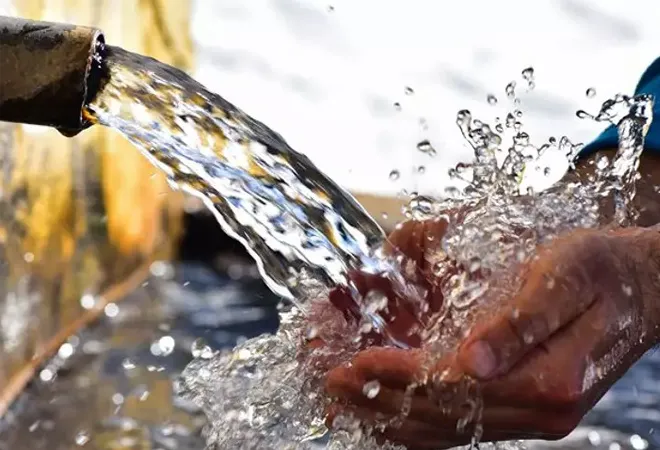
The Delhi government needs to improve the provision of adequate and clean water to its citizens. According to the 2021-22 budget of the Delhi Jal Board, the water demand (1,150 mgd) and supply (935 mgd) gap in the national capital is about 215 million gallons per day (mgd). This gap is determined based on water demand of 50 gallons per capita daily (gpcd) for a projected population of 23 million in 2021.
The negative impacts of water shortage are seen in various forms. For example, many households in informal areas do not have access to clean water. In planned areas, the frequency of piped water supply is generally two to four hours a day. Further, the situation deteriorates during the summer season when the water demand escalates.
The condition of not having sufficient access to clean and safe water makes life extremely difficult and stressful, particularly for poor communities living in slums and unauthorised colonies.
The city’s surface and groundwater reserves are low, and ongoing efforts of wastewater recycling, rainwater harvesting, and rejuvenation of water bodies are not producing desired quantities of water.
Although the Delhi government claims that 93 percent of the city’s population is covered by piped networks, and the remaining by water tankers, a lot of work remains to be done.
Delhi relies heavily on river basins in neighbouring states for meeting its raw water needs. The city’s surface and groundwater reserves are low, and ongoing efforts of wastewater recycling, rainwater harvesting, and rejuvenation of water bodies are not producing desired quantities of water.
In other words, Delhi does not have sufficient raw water within its territory. This inadequacy is also due to its geographical location in a semi-arid zone.
In the given conditions, Delhi’s dependence on its neighbours will continue. Therefore, it is important to ensure that adequate water is received from sources outside Delhi to address growing water requirements in the city. Presently, besides Delhi’s own sources (the passing river Yamuna and groundwater), raw water is received from external sources situated in neighbouring states of Haryana Carrier Lined Canal (CLC), Delhi Sub-branch (DSB) and Munak canals fed from Hathni Kund barrage on river Yamuna and Bhakra storage in Himachal Pradesh>, and Uttar Pradesh (upper Ganga canal, which originates from river Ganga at Haridwar). These states regulate the water flow to Delhi as per the water-sharing agreement. From all internal and external sources, about 935 mgd of water is being produced. To ensure an adequate supply of water to citizens, the Delhi government took steps to procure more raw water from neighbouring states.
Attempts were made to arrange additional raw water from the river Yamuna. The river originates from the Yamunotri glacier in Uttarakhand and flows through the states of Himachal Pradesh, Haryana, Delhi, and Uttar Pradesh. From this river, 342 mgd of raw water every year was to be obtained, which is estimated to be the unutilised share of Yamuna water allocated to Himachal Pradesh. For this purpose, an MoU was signed with the Himachal Pradesh government on 20 December 2019. The Haryana government was also contacted for the usage of their canal system, to bring water from Himachal Pradesh to Delhi.
The Delhi government is looking towards the completion of the following three upstream national water storage projects on river Yamuna and its tributaries.
Another proposal to obtain 140 mgd of river water from Uttar Pradesh (UP) in exchange for treated effluent (to meet UP’s irrigation requirement) was also developed. However, according to a media report published in May 2022, both these proposals were turned down by the governments of Himachal Pradesh and Uttar Pradesh. The Haryana government too opposed the idea for the reason that its canals could not carry additional water from Himachal Pradesh to Delhi.
Meanwhile, the Delhi government is looking towards the completion of the following three upstream national water storage projects on river Yamuna and its tributaries. In this regard, the Economic Survey of Delhi for 2021-22 mentions that such water augmentation measures are “entirely dependent on cooperation and constructive collaboration from neighbouring states and the Union Government.”
- Renuka dam on Giri river, Himachal Pradesh: The six states: Himachal Pradesh, Uttarakhand, UP, Haryana, Delhi, and Rajasthan—signed an agreement in January 2019 for dam construction, and its approval from Union Cabinet came in December 2021.As per a media report, the construction work will begin in December 2022 and end in six years. Delhi is expected to receive water at a rate of 23 cubic metre per second (cumecs) and will have the potential to supply 275 mgd of water to the national capital. In terms of financial contribution, the city government has paid INR 2.15 billion to the Himachal Pradesh government and also committed to bearing 90 percent of the power cost.
A delay was observed in the initiation of the project due to the non-deposit of funds in the state Compulsory Afforestation Fund Management and Planning Authority account, which in turn led to the expiry of forest clearance. Efforts are being made to resolve this matter.
- Lakhwar dam on Yamuna, Uttarakhand: This project has been allocated to Uttarakhand Jal Vidyut Nigam Limited (UJVNL). Water from here will be shared among the aforementioned six states for which an agreement was signed in August 2018. Financial approval of the project was received from the Jal Shakti Ministry in September 2021. It is reported that the project will be completed in six years from the starting date. The Delhi government has contributed INR 77.9 million for the initiation of the project (seed money) and about 135 mgd of water will be received in the national capital upon completion.
- Kishau dam on Tons river at the borders of Uttarakhand and Himachal Pradesh:
For project execution, Kishau Corporation Limited was incorporated on 16 January 2017, and the detailed project report (DPR) is in the appraisal stage. It is reported that the project would be commissioned after 96 months (eight years) from the date of start. The six beneficiary states are the same as mentioned above, and a contribution of INR 81 million has been made by the Delhi government. From this storage, Delhi is expected to receive about 372 mgd of water.
Delhi is expected to receive water at a rate of 23 cubic metre per second (cumecs) and will have the potential to supply 275 mgd of water to the national capital.
A review of the water augmentation efforts of the Delhi government presented above reveals that it will take several years to ensure water adequacy for people living in the national capital. The city’s full potential remains untapped; many internal issues are yet to be addressed. Furthermore, the completion of the three upstream national water storage projects may take six to eight years.
Further delays in the completion of dam projects are expected because of social and environmental reasons. The Renuka dam oustees, for example, are unhappy with the rehabilitation plan as well as compensation offered and are preparing for an agitation. Similar experiences are being observed in the case of the Lakhwar and Kishau projects. The environmentalists too are concerned about its ecological impact and harm to Himalayan biodiversity.
Population projections indicate that Delhi will record 28-30 million dwellers by 2041. To meet their water requirements, sustainable strategies should be pursued.
The views expressed above belong to the author(s). ORF research and analyses now available on Telegram! Click here to access our curated content — blogs, longforms and interviews.




 PREV
PREV


